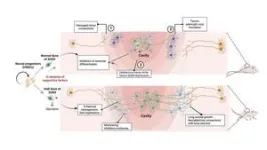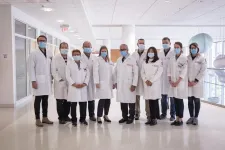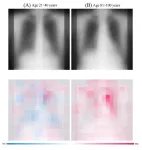(Press-News.org)
What if artificial intelligence (AI) could be used to spur discovery in areas such as biotechnology, drug discovery and fluid dynamics? Using geometric graphs and innovative methodologies, AI can solve fundamental problems in basic natural science. The possibilities are endless in this relatively new field known as AI for science.
Dr. Shuiwang Ji, a professor in the Department of Computer Science and Engineering at Texas A&M University, recently received a National Science Foundation grant to research 3D graphs and AI.
Ji aims to develop a methodology to represent molecules and proteins using 3D or geometric graphs to predict their behavior and properties. Once created, this methodology could help solve problems in physics, fluid dynamics and biotechnology.
“We try to use AI to understand the physical world we live in,” Ji said. “The findings of this research may take time to become practical, but once that happens and we develop a powerful AI method, it can be applied to many different areas because this is fundamental research. It’s similar to when the discovery of the electron led to electricity.”
Completeness, efficiency and applications
The challenge lies in the uniqueness of Ji’s project: bridging completeness, efficiency and applications in 3D graphs. Completeness refers to capturing complete information, and efficiency refers to processing large inputs. The application aspect refers to applying Ji’s methodology to molecular dynamics, molecular simulations and drug discovery. However, with this kind of work, there are usually trade-offs.
“Traditionally, if you want to capture complete input information, the process will be quite slow to train this network,” Ji said. “On the other hand, if you want the training to be fast, you cannot capture complete information. I aim to develop a method that will be both and solve different applications in molecules, proteins and material science. This might be the first time these three things are being put together.”
Understanding graphs and real-world applications
Graphs are used to represent certainties in the physical world. For instance, a standard graph could represent a social network, where each node is a person, and the edges represent relationships; if Person A is in an email communication with Person B, there is an edge from A to B.
“In science, we can characterize a problem as a geometric graph,” Ji said. “This is very different from standard graphs because each node will also have a location or coordinate in 3D space. You can consider a molecule as a geometric graph, where each atom is a node and chemical bonds characterize their relationships. Each atom also has a location in 3D space, which gives you the 3D geometry of these molecules. How the molecule will perform critically depends on 3D geometry.”
A material that geometric graphs can represent is drugs, which are made of molecules. A drug will have a 3D shape, dock to a receptor and bind a protein like a key to a lock. The 3D geometry of the drug is important because it can be formulated as a prediction problem to find out if the drug can be used as an antibiotic or not.
“The drug industry is interested in molecular dynamics, and a similar model has been used to screen a large potential antibiotic database,” Ji said. “They set out to identify a molecule that could potentially be used as an antibiotic, validated their findings in the lab and actually identified a new antibiotic.”
The applications of this project include not only drug discovery but also material science, partial differential equations and aerospace engineering, to name a few. Ji plans to focus on the methodology rather than one area of study, inviting collaboration from experts in a wide range of fields to lend insight into this work and solve many problems.
“This is a highly interdisciplinary area,” Ji said. “We use AI to solve problems in computer science, chemistry, fluid dynamics and material science, but we are not experts in these fields. It would be good to collaborate with these individuals to see what challenges they face that we can try to solve.”
Where it all began
Though Ji began this research project in August, he has been working on AI for science for a few years. He even led a technical survey review paper laying the foundation for this research project, “Artificial Intelligence for Science in Quantum, Atomistic, and Continuum Systems.” Similar to the project's goal, this 263-page paper invited collaboration from researchers of various fields, including contributions from 63 authors and 14 universities.
“Since AI for science is a relatively new area, there is not a lot of literature on the subject to reference,” Ji said. “The project is a subset of the paper and focuses on molecular dynamics or representations, representing molecules and proteins in terms of geometric graphs. The paper lays a foundation for this project to move forward.”
By Katie Satterlee, Texas A&M Engineering
END
MIAMI, FLORIDA (Aug. 17, 2023) – Researchers with Sylvester Comprehensive Cancer Center at the University of Miami Miller School of Medicine have been awarded a grant from the U.S. Department of Defense (DoD)’s Congressionally Directed Medical Research Program to target chemotherapy resistance in pancreatic cancer.
The $800,000, three-year grant is the first DoD award to Sylvester to study pancreatic cancer, a disease characterized by extreme resistance to chemotherapy and other treatments and dismal survival rates.
Pancreatic ductal adenocarcinoma is the most common and aggressive ...
(Philadelphia, PA) – A single injection of a novel CRISPR gene-editing treatment safely and efficiently removes SIV – a virus related to the AIDS-causing agent HIV – from the genomes of non-human primates, scientists at the Lewis Katz School of Medicine at Temple University now report. The groundbreaking work complements previous experiments as the basis for the first-ever clinical trial of an HIV gene-editing technology in human patients, which was authorized by the Food and Drug Administration (FDA) in 2022.
The preclinical study, published online ...
As urban areas expand, animals increasingly find themselves living in towns and cities. While some animals may benefit from milder temperatures and fewer natural predators in urban settings, they also have to cope with pollutants and changes in their diet. Previous research has shown that animals in cities are “duller” in terms of yellow-orange-red colour tones compared to their non-urban counterparts. However, previous studies have only focused on single geographic locations.
“We used feather samples collected from great tits in cities and forests across Europe. Different methods all confirmed that urban great tits ...
(Santa Barbara, Calif.) — We’ve managed to accumulate so much plastic trash that it’s daunting to think about what could be done with the tons upon tons of nonbiodegradable waste. And as much as we are trying to scale back our dependence on single-use plastics, we continue to add to the global plastic trash hoard. Events like the COVID-19 pandemic only served to expand their use for personal protective equipment and disposable and take-away packaging.
But, for researchers at UC Santa Barbara, one person’s single-use packaging ...
Group A streptococci are fairly common bacteria that can cause, among other things, strep throat or impetigo. However, if the bacteria become invasive, the situation can become very dangerous. In this case, the name sometimes changes to murder bacteria or flesh-eating bacteria and can give rise to life-threatening conditions such as blood poisoning and septic shock, or soft tissue infections that may make an amputation necessary.
Invasive streptococcal infections have increased in recent decades. The reason for this is not fully understood.
The outcome of infections can ...
Prolonged exposure to low-dose ionising radiation is associated with a higher risk of death from cancer than previously thought, suggests research tracking the deaths of workers in the nuclear industry, published in The BMJ today.
The findings should inform current rules on workplace protection from low-dose radiation, say the researchers.
To date, estimates of the effects of radiation on the risk of dying from cancer have been based primarily on studies of survivors of atomic bombs dropped on Japan at the ...
Access to a smartphone alcohol intervention app helped university students to cut down their overall alcohol consumption and the number of days they drank heavily, suggests a study published in The BMJ today.
Unhealthy drinking is the biggest risk factor to health for 15 to 49-year olds, and unhealthy use of alcohol is especially prevalent among adult students, prompting the authors to design a smartphone app to encourage healthier drinking among this group.
The authors tested the app in 1770 university students who had screened positive for ...
*Please see end of press release for a link to the embargoed content*
Peer-reviewed / Randomised Controlled Trial / People
A randomised controlled trial of 860 women requesting emergency contraception found 95% of pregnancies were prevented following combined treatment with levonorgestrel and the anti-inflammatory medication piroxicam, compared to 63% of pregnancies being prevented when levonorgestrel was taken alone.
This is the first randomised trial where piroxicam has been studied for its contraceptive action in humans.
The authors say, if these results can be reproduced in future studies, co-treatment with piroxicam and levonorgestrel ...
Osaka, Japan - What if “looking your age” refers not to your face, but to your chest? Osaka Metropolitan University scientists have developed an advanced artificial intelligence (AI) model that utilizes chest radiographs to accurately estimate a patient’s chronological age. More importantly, when there is a disparity, it can signal a correlation with chronic disease. These findings mark a leap in medical imaging, paving the way for improved early disease detection and intervention. The results are set to be published in The Lancet Healthy Longevity.
The research team, led by graduate student ...
Epilepsy in infants ranges in severity and can leave caregivers with questions about their child’s health. While genetic testing to help determine the cause of epilepsy is possible, comprehensive testing does not always happen routinely and it can take a long time, leaving families waiting for answers.
Published in The Lancet Neurology, this international study sequenced the genomes of 100 infants with unexplained seizures, along with their parents, from four countries (England, USA, Canada and Australia) to better understand the potential strengths of early, broad genome sequencing (a process ...





